International Journal of Information Technology and Computer Science @ijitcs
Статьи журнала - International Journal of Information Technology and Computer Science
Все статьи: 1254
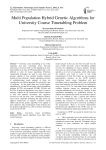
Multi Population Hybrid Genetic Algorithms for University Course Timetabling Problem
Статья научная
University course timetabling is one of the important and time consuming issues that each University is involved with it at the beginning of each. This problem is in class of NP-hard problem and is very difficult to solve by classic algorithms. Therefore optimization techniques are used to solve them and produce optimal or near optimal feasible solutions instead of exact solutions. Genetic algorithms, because of multidirectional search property of them, are considered as an efficient approach for solving this type of problems. In this paper three new hybrid genetic algorithms for solving the university course timetabling problem (UCTP) are proposed: FGARI, FGASA and FGATS. In proposed algorithms, fuzzy logic is used to measure violation of soft constraints in fitness function to deal with inherent uncertainly and vagueness involved in real life data. Also, randomized iterative local search, simulated annealing and tabu search are applied, respectively, to improve exploitive search ability and prevent genetic algorithm to be trapped in local optimum. The experimental results indicate that the proposed algorithms are able to produce promising results for the UCTP.
Бесплатно
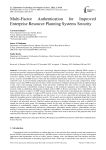
Multi-Factor Authentication for Improved Enterprise Resource Planning Systems Security
Статья научная
Universities across the globe have increasingly adopted Enterprise Resource Planning (ERP) systems, a software that provides integrated management of processes and transactions in real-time. These systems contain lots of information hence require secure authentication. Authentication in this case refers to the process of verifying an entity’s or device’s identity, to allow them access to specific resources upon request. However, there have been security and privacy concerns around ERP systems, where only the traditional authentication method of a username and password is commonly used. A password-based authentication approach has weaknesses that can be easily compromised. Cyber-attacks to access these ERP systems have become common to institutions of higher learning and cannot be underestimated as they evolve with emerging technologies. Some universities worldwide have been victims of cyber-attacks which targeted authentication vulnerabilities resulting in damages to the institutions reputations and credibilities. Thus, this research aimed at establishing authentication methods used for ERPs in Kenyan universities, their vulnerabilities, and proposing a solution to improve on ERP system authentication. The study aimed at developing and validating a multi-factor authentication prototype to improve ERP systems security. Multi-factor authentication which combines several authentication factors such as: something the user has, knows, or is, is a new state-of-the-art technology that is being adopted to strengthen systems’ authentication security. This research used an exploratory sequential design that involved a survey of chartered Kenyan Universities, where questionnaires were used to collect data that was later analyzed using descriptive and inferential statistics. Stratified, random and purposive sampling techniques were used to establish the sample size and the target group. The dependent variable for the study was limited to security rating with respect to realization of confidentiality, integrity, availability, and usability while the independent variables were limited to adequacy of security, authentication mechanisms, infrastructure, information security policies, vulnerabilities, and user training. Correlation and regression analysis established vulnerabilities, information security policies, and user training to be having a higher impact on system security. The three variables hence acted as the basis for the proposed multi-factor authentication framework for improve ERP systems security.
Бесплатно

Multi-Feature Segmentation and Cluster based Approach for Product Feature Categorization
Статья научная
At a recent time, the web has become a valuable source of online consumer review however as the number of reviews is growing in high speed. It is infeasible for user to read all reviews to make a valuable or satisfying decision because the same features, people can write it contrary words or phrases. To produce a useful summary of domain synonyms words and phrase, need to be a group into same feature group. We focus on feature-based opinion mining problem and this paper mainly studies feature based product categorization from the number of users - generated review available on the different website. First, a multi-feature segmentation method is proposed which segment multi-feature review sentences into the single feature unit. Second part of speech dictionary and context information is used to consider the irrelevant feature identification, sentiment words are used to identify the polarity of feature and finally an unsupervised clustering based product feature categorization method is proposed. Clustering is unsupervised machine learning approach that groups feature that have a high degree of similarity in a same cluster. The proposed approach provides satisfactory results and can achieve 100% average precision for clustering based product feature categorization task. This approach can be applicable to different product.
Бесплатно

Статья научная
The focus of this work is on how the congestion experienced on the GSM network can be minimized. The voice calls is broken into sub-classes of services and a level of priority is established among the classes so that the most urgent and important service will have access to the channel by preempting the lower priority services during congestion. The voice communications over the GSM network using the different classes of subscribers were analyzed with Markov chain’s model. The steady state probabilities for voice services were derived. The blocking and dropping probabilities models for the different services were developed using the Multi-dimensional Erlang B. To give a new call a fair sharing of the channel, Time-Threshold scheme is employed. This scheme classifies handoff call as either prioritised call or new call according to its associated elapsed real time value. The models were implemented based on the blocking and dropping probabilities models to show how the congestion can be minimised for different subscribers based on their priority levels. The work shows that the models used gave significant reduction in congestion when compared to the traditional Erlang-B model used in GSM.
Бесплатно

Статья научная
This paper presents solution of multi-objective optimal dispatch (MOOD) problem of solar-wind-thermal system by improved stochastic fractal search (ISFSA) algorithm. Stochastic fractal search (SFSA) is inspired by the phenomenon of natural growth called fractal. It utilizes the concept of creating fractals for conducting a search through the problem domain with the help of two main operations diffusion and updating. To improve the exploration and exploitation capability of SFSA, scale factor is used in place of random operator. The SFSA and proposed ISFSA is implemented and tested on six different multi objective complex test systems of power system. TOPSIS is used here as a decision making tool to find the best compromise solution between the two conflicting objectives. The outcomes of simulation results are also compared with recent reported methods to confirm the superiority and validation of proposed approach.
Бесплатно
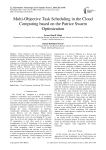
Multi-Objective Task Scheduling in the Cloud Computing based on the Patrice Swarm Optimization
Статья научная
Cloud computing is the latest emerging trend in distributed computing, where shared resources are provided to end-users in an on demand fashion that brings many advantages, including data ubiquity, flexibility of access, high availability of resources, and flexibility. In this type of systems many challenges are existed that the task scheduling problem is one of them. The task scheduling problem in Cloud computing is an NP-hard problem. Therefore, many heuristics have been proposed, from low level execution of tasks in multiple processors to high level execution of tasks. In this paper, we propose a new algorithm based on PSO to schedule the tasks in the Cloud. The results demonstrated that the proposed algorithm has a better operation in terms of task execution time, waiting time and missed tasks in comparison of First Come First Served (FCFS), Shortest Process Next (SPN) and Highest Response Ratio Next (HRRN).
Бесплатно

Multi-agent System for Management of Data from Electrical Smart Meters
Статья научная
The smart meter can process sensor data in a residential grid. These sensors transmit different parameters or measurement data (index, power, temperature, fluctuation of voltage and electricity, etc.) to the smart meter. All of these measurement data can come in different ways at the smart meter. The sensors transmit each measurement data to the smart meter. In addition, the collection of this data to a central system is a significant concern to ensure data integrity and protect the privacy of residents. The complexity of these data management also lies in their volume, frequency, and scheduling. This work presents a scheduling and a collection mechanism in private power consumption data between both sensors and smart meters on one hand and between smart meters and the central data collection system on other hand. We have found several approaches to intelligent meter data management in scientific researches. We propose another approach in response to this concern for the scheduling and collection of measurement data to a central system from residential areas of sensors’ network connected to smart meters. This work is also an example of a link between data collection and data scheduling in intelligent information management, transmission, and protection. We also propose a modeling of the measurement objects of smart grid and highlight the changes made to these objects throughout the process of data processing. It should be noted that this smart grid system consists of three main active systems namely sensors, smart meters and central system. In addition to these three systems, there are other systems that communicate with the smart meters and the central system. We have identified three implementation models for the smart metering system. We also present an intelligent architecture based on multi-agent systems for the smart grid. Most current electricity management systems are not adapted to the new challenges imposed by social and economic development in Africa. The objectives of this study are to initiate the design of a smart grid system for the management of electricity data.
Бесплатно

Статья научная
Emotions are pivotal in the learning process, highlighting the importance of identifying students' emotional states within educational settings. While neural network models, particularly those rooted in deep learning, have demonstrated remarkable accuracy in detecting primary emotions like happiness, sadness, fear, disgust, and anger from facial expressions in videos, these emotions occur infrequently in learning environments. Conversely, cognitive emotions such as engagement, confusion, frustration, and boredom are significantly more prevalent, transpiring five times more frequently than basic emotions. However, unlike basic emotions which are relatively distinct, cognitive emotions present a subtler distinction, necessitating the utilization of more sophisticated models for accurate recognition. The proposed work presents an efficient Facial Expression Recognition (FER) model for monitoring the student engagement in a learning environment by considering their facial expressions like boredom, frustration, confusion and engagement. The proposed methodology includes certain pre-processing steps followed by facial expression recognition founded on Efficient-Net B3 CNN in which the learning parameters are optimized using Circle-Inspired Optimization Algorithm (CIOA). Finally, the post processing stage estimates the frame-wise group engagement level (GEL) of students based on certain expression labels. Based on the acquired results, it is noted that the suggested Efficient-Net B3 CNN-CIOA based FER model provides promising results in terms of accuracy by 99.5%, precision by 99.2%, recall by 99.5% and f1-score by 99.6%, when compared with some state-of-art facial expression recognition approaches. Also, the suggested approach computational complexity is very much less than the compared existing approaches.
Бесплатно

Multi-platform code generation supported by domain-specific modeling
Статья научная
Code generation is widely used to make software development more efficient and less prone to human errors. A significant use case of code generation is processing of Domain-Specific Languages (DSLs) and Domain-Specific Models (DSMs). Sometimes, it is desired to generate semantically equivalent or similar functionality to different languages to better support multiple platforms and achieve better reuse in the tooling. For example, it is convenient if a single tool supports code generating from a DSM to either Java or C#. There has been relevant research on using modeling and model transformations for code generation to multiple platforms. The Model-Driven Architecture (MDA) inherently supports multi-platform code generation based on models. Nevertheless, the MDA standard is a high-level general framework that includes standards, notions and principles but does not specify more concrete methods or workflows about their efficient adoption. Our research focuses on the efficient and practically usable application of MDA principles to generate multi-platform code. This paper reports on our results on multi-platform code generation and the difficulties that we are about to addressed in future research. The approach and the challenges presented in the paper are useful for tool developers, such as developers of DSLs, who generates code for several platforms.
Бесплатно

Multi-stage Transfer Learning for Fake News Detection Using AWD-LSTM Network
Статья научная
In the recent decades, the automatic veracity verification of rumors is essential, since online social media platforms allow users to post news item or express opinion towards a circulating piece of information without much restriction. The intention of fake news is to make the readers believe in inaccurate information, where the detection of fake news by using content is a difficult task. So, the auxiliary information: user profile, social engagement of the users, and other user’s comments are useful in the detection of fake news. In this manuscript, a novel multi-stage transfer learning approach is introduced for an effective fake news detection, where it utilizes user’s comments as auxiliary information to detect whether the given tweet is true or false. The stances of the response tweets contain opinions on news/rumors are often used for verifying the veracity of the circulating information. In order to devastate the effects of the specific rumors at the earliest, the multi-stage transfer learning approach automatically predict veracity of rumors jointly with the stances of their response tweets. The proposed multi-stage transfer learning is an inductive transfer learning variation that is used to forecast the stance of responses, then to identify fake news. The proposed model’s effectiveness is evaluated on the two-benchmark datasets: semEval-2017 task 8 and PHEME. The proposed model outperformed the existing approaches by obtaining a classification accuracy of 64.30% and 65.30%, an F-measure of 65.95% and 63.90% on semEval-2017 task 8, and PHEME on event-wise datasets.
Бесплатно

Multiple Ranks Weighting Score for Microscopic Image Retrieval System
Статья научная
Content based medical images have become a major necessity with the growing retrieving Advancements. CBIR access to medical images for supporting clinical decision making has been proposed that would be ease to manage large number of image in the database system. [4] In real time case only few systems has been developed and used in clinical environment. Content-Based Image Retrieval refers to image retrieval system that is based on visual properties of image objects other than textual annotation. Query image features compare with the database image features which is not exactly matching so image feature can be compare with the two tier approach in the database image in order to improve the accuracy of the retrieval system. Every day, large volume of different types of medical images such as MRI, CT images ultrasound, x-ray, radiology, etc are produced in different medical centre’s .microscopic image classification and discrimination (sub-type) [12] is the most difficult problem in medical image retrieval system. In this paper, the survey provides the suitable algorithm for retrieval and classification of medical image to improve the overall accuracy of the MIMS.
Бесплатно

Multiresolution Fuzzy C-Means Clustering Using Markov Random Field for Image Segmentation
Статья научная
In this paper, an unsupervised multiresolution image segmentation algorithm is put forward, which combines interscale and intrascale Markov random field and fuzzy c-means clustering with spatial constraints. In the initial label determination of wavelet coefficient phase, the statistical distribution property of wavelet coefficients is characterized by Gaussian mixture model, the properties of intrascale clustering and interscale persistence of wavelet coefficients are captured by Markov prior probability model. According to maximum a posterior rule, the initial label of wavelet coefficient from coarse to fine scale is determined. In the image segmentation phase, in order to overcome the shortcomings of conventional fuzzy c-means clustering, such as being sensitive to noise and lacking of spatial constraints, we construct the novel fuzzy c-means objective function based on the property of intrascale clustering and interscale persistence of wavelet coefficients, taking advantage of Lagrange multipliers, the improved objective function with spatial constraints is optimized, the final label of wavelet coefficient is determined by iteratively updating the membership degree and cluster centers. The experimental results on real magnetic resonance image and peppers image with noise show that the proposed algorithm obtains much better segmentation results, such as accurately differentiating different regions and being immune to noise.
Бесплатно

Myanmar-English Bidirectional Machine Translation System with Numerical Particles Identification
Статья научная
This paper the development of Myanmar-English bidirectional machine translation system is implemented applying Rule based machine translation approach. Stanford and ML2KR parsers are used for preprocessing step. From this step, parsers generate corresponding parse tree structures. Used parsers generate corresponding CFG rules which are collected and created as synchronous context free grammar SCFG rules. Myanmar language can be written free order style, but it must be verb final structure. Therefore, CFG rules are required for reordering the structure of the two languages. After that tree to tree transformation is carried on the source tree structure which corresponds with used parser (Stanford parser or ML2KR's parser). When source parse tree is transformed as target parse tree, it is changed according to the SCFG rules. And then system carries out the morphological synthesis. In this stage, we need to solve only for English to Myanmar machine translation because Myanmar language is morphologically rich language. Therefore, particles for Myanmar language can be solved in this system by proposed algorithm. After finishing morphological synthesis, this system generates meaningful and appropriate smoothing sentences.
Бесплатно
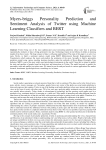
Статья научная
Twitter being one of the most sophisticated social networking platforms whose users base is growing exponentially, terabytes of data is being generated every day. Technology Giants invest billions of dollars in drawing insights from these tweets. The huge amount of data is still going underutilized. The main of this paper is to solve two tasks. Firstly, to build a sentiment analysis model using BERT (Bidirectional Encoder Representations from Transformers) which analyses the tweets and predicts the sentiments of the users. Secondly to build a personality prediction model using various machine learning classifiers under the umbrella of Myers-Briggs Personality Type Indicator. MBTI is one of the most widely used psychological instruments in the world. Using this we intend to predict the traits and qualities of people based on their posts and interactions in Twitter. The model succeeds to predict the personality traits and qualities on twitter users. We intend to use the analyzed results in various applications like market research, recruitment, psychological tests, consulting, etc, in future.
Бесплатно
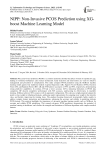
NIPP: Non-Invasive PCOS Prediction using XG-boost Machine Learning Model
Статья обзорная
Polycystic Ovary Syndrome (PCOS) is a common endocrine disorder that affects women of reproductive age, leading to hormonal imbalances and ovarian dysfunction. Early detection and intervention are vital for effective management and prevention of complications. This study compares PCOS prediction using the XGBoost machine learning model against four traditional models: Logistic Regression (LR), Support Vector Machine (SVM), Decision Trees (DT), and Random Forests (RF). LR and SVM achieve accuracies of 95% and 96%, respectively, demonstrating strong predictive capabilities. In contrast, DT had a lower accuracy (82%), indicating limitations in PCOS data complexity. RF showed competitive performance with 96% accuracy, underscoring its effectiveness in ensemble learning. XGBoost achieves 98% accuracy with its parameter configuration. The scale pos weight parameter adjusts the positive class weight in imbalanced datasets, addressing under representation by assigning more weight to the minority class, and thereby improving the training focus. The gradient boosting framework incrementally builds models to address complex feature interactions and dependencies, enhancing the accuracy and stability in predicting intricate PCOS dataset. This analysis highlights the importance of advanced machine learning models such as XGBoost for accurate and reliable PCOS predictions. This research advances PCOS prediction, demonstrates the potential of machine learning in healthcare, and clarifies the strengths and limitations of different algorithms with complex medical datasets.
Бесплатно

New RLS Wiener Smoother for Colored Observation Noise in Linear Discrete-time Stochastic Systems
Статья научная
In the estimation problems, rather than the white observation noise, there are cases where the observation noise is modeled by the colored noise process. In the observation equation, the observed value y(k) is given as a sum of the signal z(k)=Hx(k) and the colored observation noise v_c(k). In this paper, the observation equation is converted to the new observation equation for the white observation noise. In accordance with the observation equation for the white observation noise, this paper proposes new RLS Wiener estimation algorithms for the fixed-point smoothing and filtering estimates in linear discrete-time wide-sense stationary stochastic systems. The RLS Wiener estimators require the following information: (a) the system matrix for the state vector x(k); (b) the observation matrix H; (c) the variance of the state vector x(k); (d) the system matrix for the colored observation noise v_c(k); (e) the variance of the colored observation noise.
Бесплатно
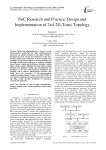
NoC Research and Practice: Design and Implementation of 2×4 2D-Torus Topology
Статья научная
Design and Implementation of network on chip interconnection architecture for eight compute-intensive processors are mainly presented in this paper. Firstly, it introduces the basic concept and architecture of the NoC, through analysis and comparison of three common NoC topologies, 2×4 2D Turos is chosen as the final topology, and the single routing node architecture is designed, including packet format, routing and arbitration. Secondly, routing nodes coding, routing algorithm and node degree routing direction are designed. Thirdly, the programming and simulation of 2×4 NoC interconnection architecture are designed, and it achieves uninterrupted operation. The result shows the correctness of the interconnection architecture design. Finally, it chooses XC4VSX55-12ff1148 of vertext 4 to synthesize, the maximum frequency can up to 268 MHz, which provides foundation of subsequent research and application.
Бесплатно

Статья научная
Social networks constitute a suitable forum for debate, and exchange on any sort of topic especially highly sensitive issues. They offer a fertile platform for debate on thorny societal issues such as politics, sex, culture and religion among others. Given the fact that they favor anonymity, openness and non-accountability for voiced opinion, a good number of Nigerians have found them suitable for, "hot", "aggressive" and very passionate discussions over subjects like sex, sexuality and religious convictions – issues which have remarkably remained somehow taboos in the Nigerian society. This paper investigates the conduct of online debates and opinion formation on sex in the prolific Nigerian motion picture industry (Nollywood). It is based on the content analysis of 516 comments by Nigerians, reacting or debating online (in social networks) on pornography in the Nigerian film industry. The paper seeks to explore and quantify the phenomenon of noise in online communication (conservation and debate) on sex by Nigerians. It equally examines how this noise affects communication flow in online debate on pornography in the Nigerian film industry. It argues that being somewhat considerable, noise in such a communication context, is mainly psychological in nature, due principally to the dominance of conservative beliefs on sex and pornography in the Nigerian society. This conservatism motivates most Nigerians to mainly have preconceived stereotypes, notions and biases on sex and pornography and to adopt judgmental and censuring reactions to most attempts to celebrate pornography. The effect of the psychological noise (as observed in online conversation on pornography) is mainly to orchestrate a change of topic from sex to other sensitive issues as politics and religion or engender insults and counter insults which further negatively affect communication.
Бесплатно

Non-polynomial Spline Difference Schemes for Solving Second-order Hyperbolic Equations
Статья научная
In this paper, a class of improved methods based on non-polynomial cubic splines in space and finite difference in time direction are constructed for the second-order hyperbolic equations with initial boundary value problems. Truncation error and stability analysis of the methods have been carried out. It is shown that by suitably choosing the parameters, many known methods can be derived from ours. We also obtain a new high accuracy scheme of , which is conditionally stable for .Finally, a numerical experiment is tested and results are compared with other published numerical solutions.
Бесплатно

Статья научная
This paper derives a new procedure for age classification of facial image based on the local region of facial image. The local region of facial image is extracted from a Significant Binary Pattern of Local Maximum Edge (SBPLME). The SBPLME is generated by calculating the absolute value of local difference between the average of local 3×3 sub window pixel values and its neighbors instead of the center pixel value. In the case of Local Maximum Edge Binary Pattern (LMEBP) calculating the absolute value of local difference between the center pixel value of local 3×3 sub window and its neighbors. The proposed SBPLME can generate 512 (0 to 511) different patterns. The present paper utilized Prominent LBP (PLBP) on the proposed SBPLME. The PLBP contains the significant patterns of Uniform LBP (ULBP) and Non Uniform LBP (NULBP). Thus the derived Significant PLBP of Local Maximum Edge (SPBPLME) becomes an efficient image classification and analysis, which will have a significant role in many areas. The novelty of the proposed SPBPLME method is, it has shown excellent age classification results by reducing the overall dimension, thus reducing the overall complexity.
Бесплатно

